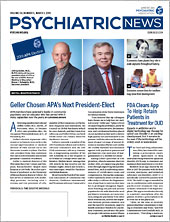As many as 1 in 4 children who has a parent with bipolar disorder may go on to develop the disorder. A large prospective study published in AJP in Advance suggests that childhood sleep and anxiety disorders may be important predictors of the illness.
“For clinicians, in order to accurately diagnose emerging psychiatric disorders, we need to take into account the developmental trajectory of emerging psychopathology as well as the family history of psychiatric illness,” lead study author Anne Duffy, M.D., a professor in the Department of Psychiatry at Queen’s University in Canada, told Psychiatric News. “Symptoms alone are not sufficient information to make a stable and accurate diagnosis.”
The study included 279 “high-risk” participants (aged 5 to 25 years) who had one parent diagnosed with bipolar I or bipolar II disorder. The researchers categorized the high-risk participants into two groups, according to how their parents responded to lithium. Parents of the participants were considered to be “responsive to lithium” if they had no new recurrences over at least three years while on the medication; all others were considered nonresponsive to the medication. Also included in the study were 87 “comparison” participants—those with similar socioeconomic backgrounds from Ottawa schools whose parents had had no history of major psychiatric disorder.
Participants were followed for up to 21 years, about 8 years on average for the high-risk group. All participants completed research assessments administered by a psychiatrist at baseline and about every year thereafter.
The researchers observed bipolar spectrum disorders in 25 percent of the “high-risk” offspring, with an average age of onset of 21 years old, while about 11 percent of the group were diagnosed with psychotic spectrum disorders. Neither disorder was observed in the comparison group. The researchers found evidence that earlier age of onset of parental bipolar disorder was associated with an increased risk of mood disorder, including bipolar disorder and depression, in the offspring.
The researchers found no difference in the prevalence of bipolar disorder among participants based on whether their parent responded to lithium; however, psychotic disorders manifested almost exclusively among the offspring of lithium-nonresponsive parents (20 percent compared with 1 percent).
Individuals with childhood anxiety disorder or a sleep disorder were nearly twice as likely to develop a mood disorder, Duffy and colleagues found. Subthreshold depressive or manic symptoms were even more telling, and participants with such symptoms were 2.7 times more likely and 2.3 times more likely, respectively, to develop a mood disorder.
“The implication is that clinically significant anxiety, mood, and sleep symptoms in children at confirmed familial risk for bipolar disorder identify an ultra-high-risk group that likely warrants closer surveillance and support,” the researchers wrote.
The researchers diagnosed major depressive disorder almost exclusively among the high-risk offspring (33 percent of the high-risk group versus 5 percent of the comparison group). A similar pattern emerged for sleep disorders (23 percent of high-risk group versus none of the comparison group).
Bipolar disorder typically unfolded in a progressive clinical sequence in individuals with familial risk, Duffy said. Depressive episodes were predominant early in the illness, especially among the offspring of individuals who responded to lithium.
This study did not, however, find evidence to support a proposed pediatric bipolar subtype of illness in childhood characterized by chronic rapid fluctuating moodiness, irritability, neurodevelopmental disorder, and explosive temper. “This suggests this phenotype has nothing to do with bipolar disorder that persists into adulthood,” Duffy said.
Overall the findings indicate the role that anxiety, sleep disorders, and major depression—especially with psychotic symptoms—may play in the development of bipolar disorder in young people with a familial risk. “Early clinical intervention and prevention efforts,” the researchers wrote, “should emphasize low-risk interventions addressing mood symptoms, anxiety and sleep disorders, and prevention of substance misuse.”
The study was supported by a grant from the Canadian Institutes of Health Research. ■
“The Emergent Course of Bipolar Disorder: Observations Over Two Decades From the Canadian High-Risk Offspring Cohort” can be accessed
here.

